Seat Pressure Asymmetries after Cycling at Constant Intensity
Abstract
:1. Introduction
2. Materials and Methods
2.1. Participants
2.2. Experimental Design
2.3. Dual Energy X-ray Absorptiometry
2.4. Seat Pressure Distribution
- Distribution of contact area (%) of the right and left femoral, and right and left gluteal parts. The relative contact area was divided into four parts based on the center of pressure (COP) coordinates.
- Peak pressure (N/cm2) under the ischial tuberosity on a 3.2 cm2 area. This was calculated between the maximum four adjacent sensing elements of the seat pressure mapping sensor. The ischial tuberosity ratio was calculated by dividing the peak pressure of the right side with the peak pressure of the left. Asymmetry was determined by an unequal relationship between these parameters.
- Length of COP trajectory (cm) to measure sitting stability.
2.5. EMG Recording and Analysis during Cycling
2.6. Statistical Analysis
3. Results
4. Discussion
5. Conclusions
Author Contributions
Funding
Data Availability Statement
Acknowledgments
Conflicts of Interest
References
- Oja, P.; Titze, S.; Bauman, A.; de Geus, B.; Krenn, P.; Reger-Nash, B.; Kohlberger, T. Health benefits of cycling: A systematic review. Scand. J. Med. Sci. Sports 2011, 21, 496–509. [Google Scholar] [CrossRef] [PubMed]
- Warburton, D.E.; Charlesworth, S.; Ivey, A.; Nettlefold, L.; Bredin, S.S. A systematic review of the evidence for Canada’s physical activity guidelines for adults. Int. J. Behav. Nutr. Phys. Act. 2010, 11, 7–39. [Google Scholar] [CrossRef] [PubMed]
- Chavarrias, M.; Carlos-Vivas, J.; Collado-Mateo, D.; Pérez-Gómez, J. Health benefits of indoor cycling: A systematic review. Medicina 2019, 55, 452. [Google Scholar] [CrossRef] [PubMed]
- Carpes, F.P.; Mota, C.B.; Faria, I.E. On the bilateral asymmetry during running and cycling—A review considering leg preference. Phys. Ther. Sport 2010, 11, 136–142. [Google Scholar] [CrossRef] [PubMed]
- Clarsen, B.; Krosshaug, T.; Bahr, R. Overuse injuries in professional road cyclists. Am. J. Sports Med. 2010, 38, 2494–2501. [Google Scholar] [CrossRef] [PubMed]
- Bini, R.R.; Hunter, J.R. Pain and body position on the bicycle in competitive and recreational road cyclists: A retrospective study. Sports Biomech. 2023, 22, 522–535. [Google Scholar] [CrossRef] [PubMed]
- Visentini, P.J.; McDowell, A.H.; Pizzari, T. Factors associated with overuse injury in cyclists: A systematic review. J. Sci. Med. Sport 2022, 25, 391–398. [Google Scholar] [CrossRef] [PubMed]
- De Bernardo, N.; Barrios, C.; Vera, P.; Laíz, C.; Hadala, M. Incidence and risk for traumatic and overuse injuries in top-level road cyclists. J. Sports Sci. 2012, 30, 1047–1053. [Google Scholar] [CrossRef]
- Dingwell, J.B.; Joubert, J.E.; Diefenthaeler, F.; Trinity, J.D. Changes in muscle activity and kinematics of highly trained cyclists during fatigue. IEEE Trans. Biomed. Eng. 2008, 55, 2666–2674. [Google Scholar] [CrossRef]
- Verma, R.; Hansen, E.A.; de Zee, M.; Madeleine, P. Effect of seat positions on discomfort, muscle activation, pressure distribution and pedal force during cycling. J. Electromyogr. Kinesiol. 2016, 27, 78–86. [Google Scholar] [CrossRef]
- MacIntosh, B.R.; Neptune, R.R.; Horton, J.F. Cadence, power, and muscle activation in cycle ergometry. Med. Sci. Sports Exerc. 2000, 32, 1281–1287. [Google Scholar] [CrossRef]
- Rooney, D.; Sarriegui, I.; Heron, N. “As easy as riding a bike”: A systematic review of injuries and illness in road cycling. BMJ Open Sport Exerc. Med. 2020, 9, 6. [Google Scholar] [CrossRef]
- Yum, H.; Kim, H.; Lee, T.; Park, M.S.; Lee, S.Y. Cycling kinematics in healthy adults for musculoskeletal rehabilitation guidance. BMC Musculoskelet. Disord. 2021, 22, 1044. [Google Scholar] [CrossRef]
- Holliday, W.; Swart, J. A dynamic approach to cycling biomechanics. Phys. Med. Rehabil. Clin. N. Am. 2022, 33, 1–13. [Google Scholar] [CrossRef]
- Chen, Y.L. Predicting external ischial tuberosity width for both sexes to determine their bicycle-seat sizes. Int. J. Ind. Ergon. 2018, 64, 118–121. [Google Scholar] [CrossRef]
- Goossens, R.H.M.; Teeuw, R.; Snijders, C.J. Sensitivity for pressure difference on the ischial tuberosity. Ergonomics 2005, 48, 895–902. [Google Scholar] [CrossRef]
- Bressel, E.; Larson, B.J. Bicycle seat designs and their effect on pelvic angle, trunk angle, and comfort. Med. Sci. Sports Exerc. 2003, 35, 327–332. [Google Scholar] [CrossRef] [PubMed]
- Bressel, E.; Reeve, T.; Parker, D.; Cronin, J. Influence of bicycle seat pressure on compression of the perineum: A mri analysis. J. Biomech. 2007, 40, 198–202. [Google Scholar] [CrossRef]
- Bressel, E.; Nash, D.; Dolny, D. Association between attributes of a cyclist and bicycle seat pressure. J. Sex. Med. 2010, 7, 3424–3433. [Google Scholar] [CrossRef] [PubMed]
- Johnson, D.B.; Varacallo, M. Ischial bursitis. In StatPearls; StatPearls Publishing: St. Petersburg, FL, USA, 2023. [Google Scholar]
- Dettori, N.J.; Norvell, D.C. Non-traumatic bicycle injuries a review of the literature. Sports Med. 2006, 36, 7–18. [Google Scholar] [CrossRef] [PubMed]
- Makhsous, M.; Lin, F.; Bankard, J.; Hendrix, R.W.; Hepler, M.; Press, J. Biomechanical effects of sitting with adjustable ischial and lumbar support on occupational low back pain: Evaluation of sitting load and back muscle activity. BMC Musculoskelet. Disord. 2009, 10, 17. [Google Scholar] [CrossRef]
- Srinivasan, J.; Balasubramanian, V. Low back pain evaluation for cyclist using sEMG: A comparative study between bicyclist and aerobic cyclist. IFMBE Proc. 2009, 23, 1140–1143. [Google Scholar] [CrossRef]
- De Looze, M.P.; Kuijt-Evers, L.F.M.; Van Dieën, J. Sitting comfort and discomfort and the relationships with objective measures. Ergonomics 2003, 46, 985–997. [Google Scholar] [CrossRef] [PubMed]
- Carpes, F.P.; Dagnese, F.; Kleinpaul, J.F.; Martins, E.d.A.; Mota, C.B. Effects of workload on seat pressure while cycling with two different saddles. J. Sex. Med. 2009, 6, 2728–2735. [Google Scholar] [CrossRef] [PubMed]
- McDonald, R.; Holliday, W.; Swart, J. Muscle recruitment patterns and saddle pressure indexes with alterations in effective seat tube angle. Sports Med. Health Sci. 2022, 4, 29–37. [Google Scholar] [CrossRef] [PubMed]
- Vicari, D.S.S.; Patti, A.; Giustino, V.; Figlioli, F.; Alamia, G.; Palma, A.; Bianco, A. Saddle pressures factors in road and off-road cyclists of both genders: A narrative review. J. Funct. Morphol. Kinesiol. 2023, 8, 71. [Google Scholar] [CrossRef]
- Potter, J.J.; Sauer, J.L.; Weisshaar, C.L.; Thelen, D.G.; Ploeg, H.L. Gender differences in bicycle saddle pressure distribution during seated cycling. Med. Sci. Sports Exerc. 2008, 40, 1126–1134. [Google Scholar] [CrossRef]
- McKay, A.K.A.; Stellingwerff, T.; Smith, E.S.; Martin, D.T.; Mujika, I.; Goosey-Tolfrey, V.L.; Sheppard, J.; Burke, L.M. Defining training and performance caliber: A participant classification framework. Int. J. Sports Physiol. Perform. 2022, 17, 317–331. [Google Scholar] [CrossRef]
- Gemery, J.M.; Nangia, A.K.; Mamourian, A.C.; Reid, S.K. Digital three-dimensional modelling of the male pelvis and bicycle seats: Impact of rider position and seat design on potential penile hypoxia and erectile dysfunction. BJU Int. 2007, 99, 135–140. [Google Scholar] [CrossRef]
- Hermens, H.J.; Freriks, B.; Disselhorst-Klug, C.; Rau, G. Development of recommendations for semg sensors and sensor placement procedures. J. Electromyogr. Kinesiol. 2000, 10, 361–374. [Google Scholar] [CrossRef]
- Wang, L.; Wang, Y.; Ma, A.; Ma, G.; Ye, Y.; Li, R.; Lu, T. A comparative study of EMG indices in muscle fatigue evaluation based on grey relational analysis during all-out cycling exercise. Biomed. Res. Int. 2018, 2018, 9341215. [Google Scholar] [CrossRef]
- Cohen, J. Statistical Power Analysis for the Behavioral Sciences, 2nd ed.; Routledge: London, UK, 1988. [Google Scholar] [CrossRef]
- Hopkins, W.G.; Marshall, S.W.; Batterham, A.M.; Hanin, J. Progressive statistics for studies in sports medicine and exercise science. Med. Sci. Sports Exerc. 2009, 41, 3–12. [Google Scholar] [CrossRef] [PubMed]
- Lindström, L.; Kadefors, R.; Petersen, I. An electromyographic index for localized muscle fatigue. J. Appl. Physiol. Respir. Environ. Exerc. Physiol. 1977, 43, 750–754. [Google Scholar] [CrossRef] [PubMed]
- Balasubramanian, V.; Jagannath, M.; Adalarasu, K. Muscle fatigue based evaluation of bicycle design. Appl. Ergon. 2014, 45, 339–345. [Google Scholar] [CrossRef] [PubMed]
- Masuda, K.; Masuda, T.; Sadoyama, T.; Inaki, M.; Katsuta, S. Changes in surface emg parameters during static and dynamic fatiguing contractions. J. Electromyogr. Kinesiol. 1999, 9, 39–46. [Google Scholar] [CrossRef] [PubMed]
- Bigland-Ritchie, B.; Furbush, F.; Woods, J.J. Fatigue of intermittent submaximal voluntary contractions: Central and peripheral factors. J. Appl. Physiol. 1986, 61, 421–429. [Google Scholar] [CrossRef] [PubMed]
- Arendt-Nielsen, L.; Mills, K.R. Muscle fibre conduction velocity, mean power frequency, mean emg voltage and force during submaximal fatiguing contractions of human quadriceps. Eur. J. Appl. Physiol. Occup. Physiol. 1988, 58, 20–25. [Google Scholar] [CrossRef]
- St Clair Gibson, A.; Schabort, E.J.; Noakes, T.D. Reduced neuromuscular activity and force generation during prolonged cycling. Am. J. Physiol. Regul. Integr. Comp. Physiol. 2001, 281, 187–196. [Google Scholar] [CrossRef]
- Lin, Z.-J.; Wang, H.-H.; Chen, C.-H. Effect of bicycle saddle widths on saddle pressure in female cyclists. J. Sports Sci. Med. 2023, 22, 425–430. [Google Scholar] [CrossRef]
- Holliday, W.; Fisher, J.; Swart, J. The effects of relative cycling intensity on saddle pressure indexes. J. Sci. Med. Sport 2019, 22, 1097–1101. [Google Scholar] [CrossRef]
- Albero, J.R.; Pérez-Soriano, P.; Encarnación-Martínez, A. The effect of saddle setback and cycling intensity on saddle pressures and comfort in male and female recreational cyclists. J. Sports Sci. 2023, 41, 999–1007. [Google Scholar] [CrossRef] [PubMed]
- Sanford, T.; Gadzinski, A.J.; Gaither, T.; Osterberg, E.C.; Murphy, G.P.; Carroll, P.R.; Breyer, B.N. Effect of oscillation on perineal pressure in cyclists: Implications for micro-trauma. J. Sex. Med. 2018, 6, 239–247. [Google Scholar] [CrossRef] [PubMed]
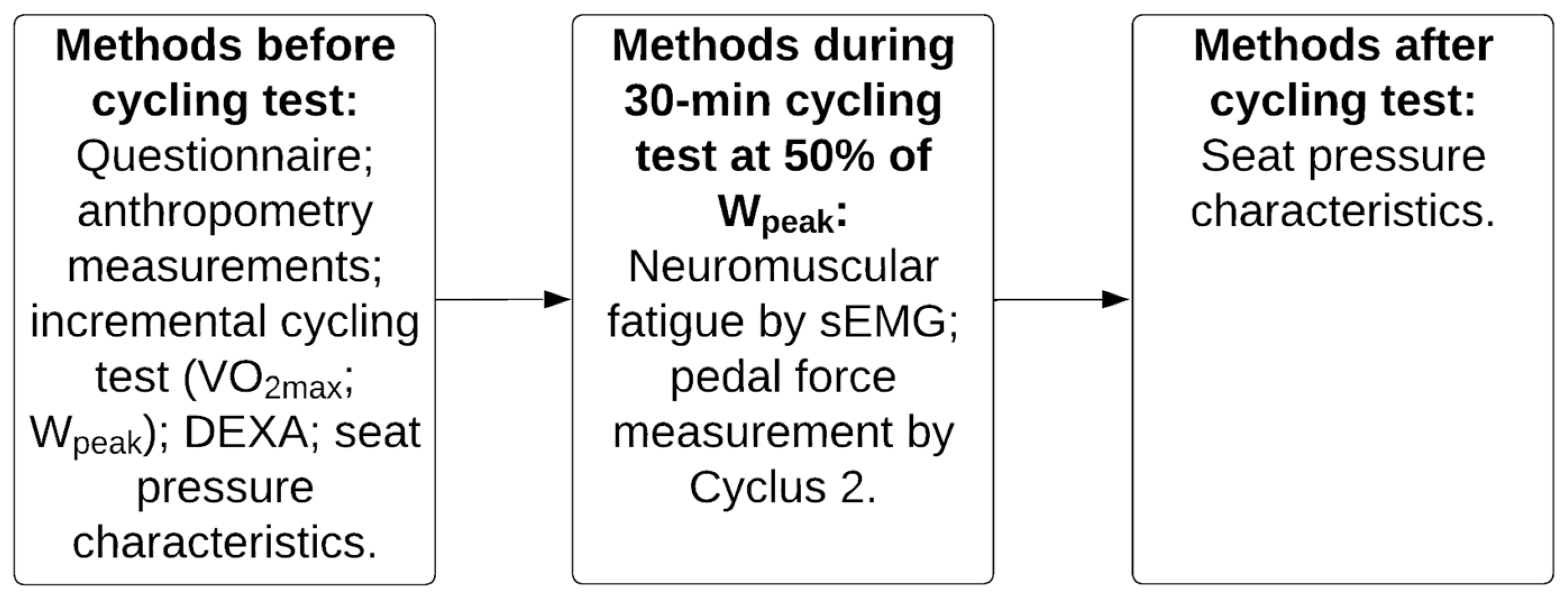

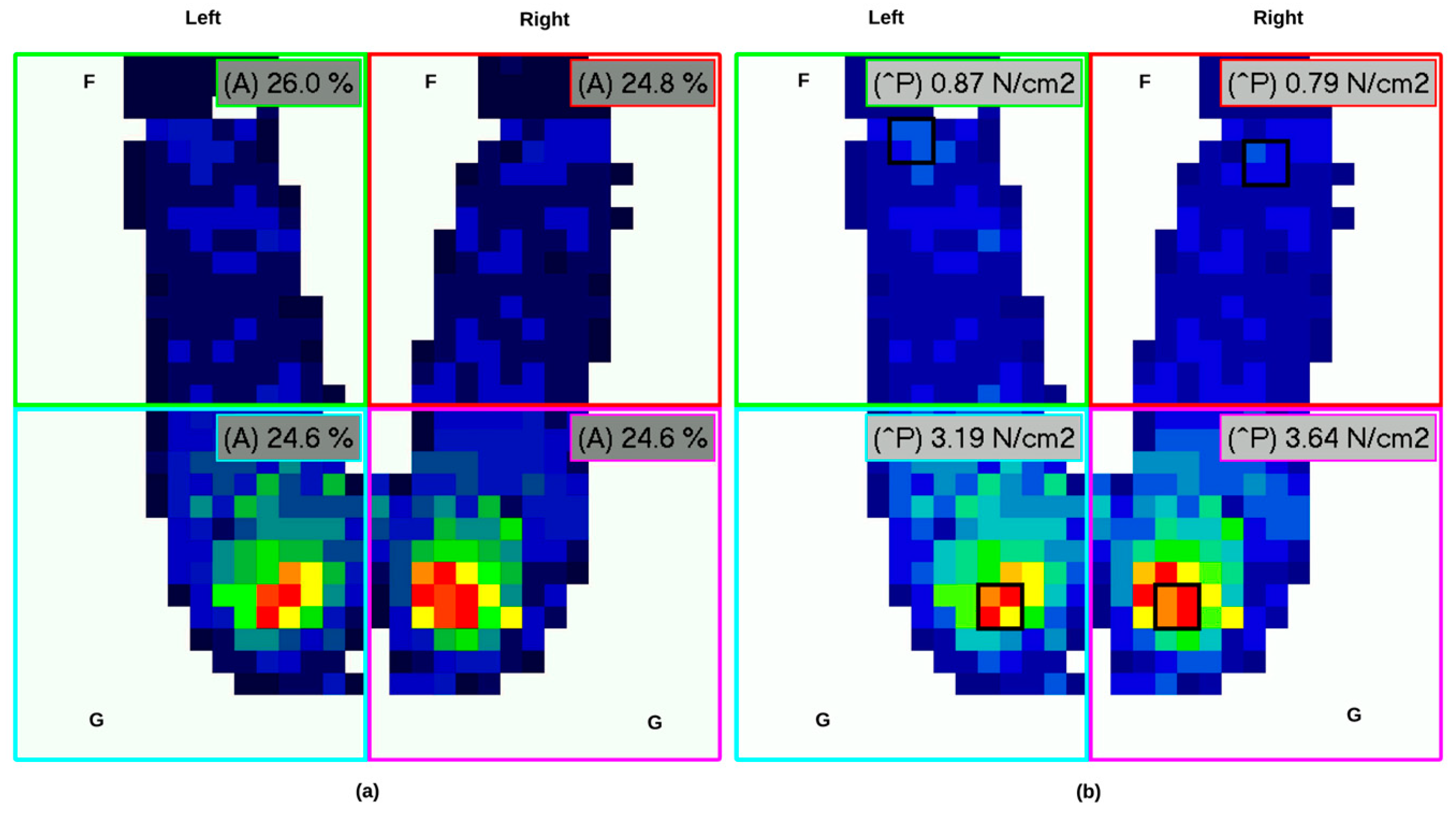
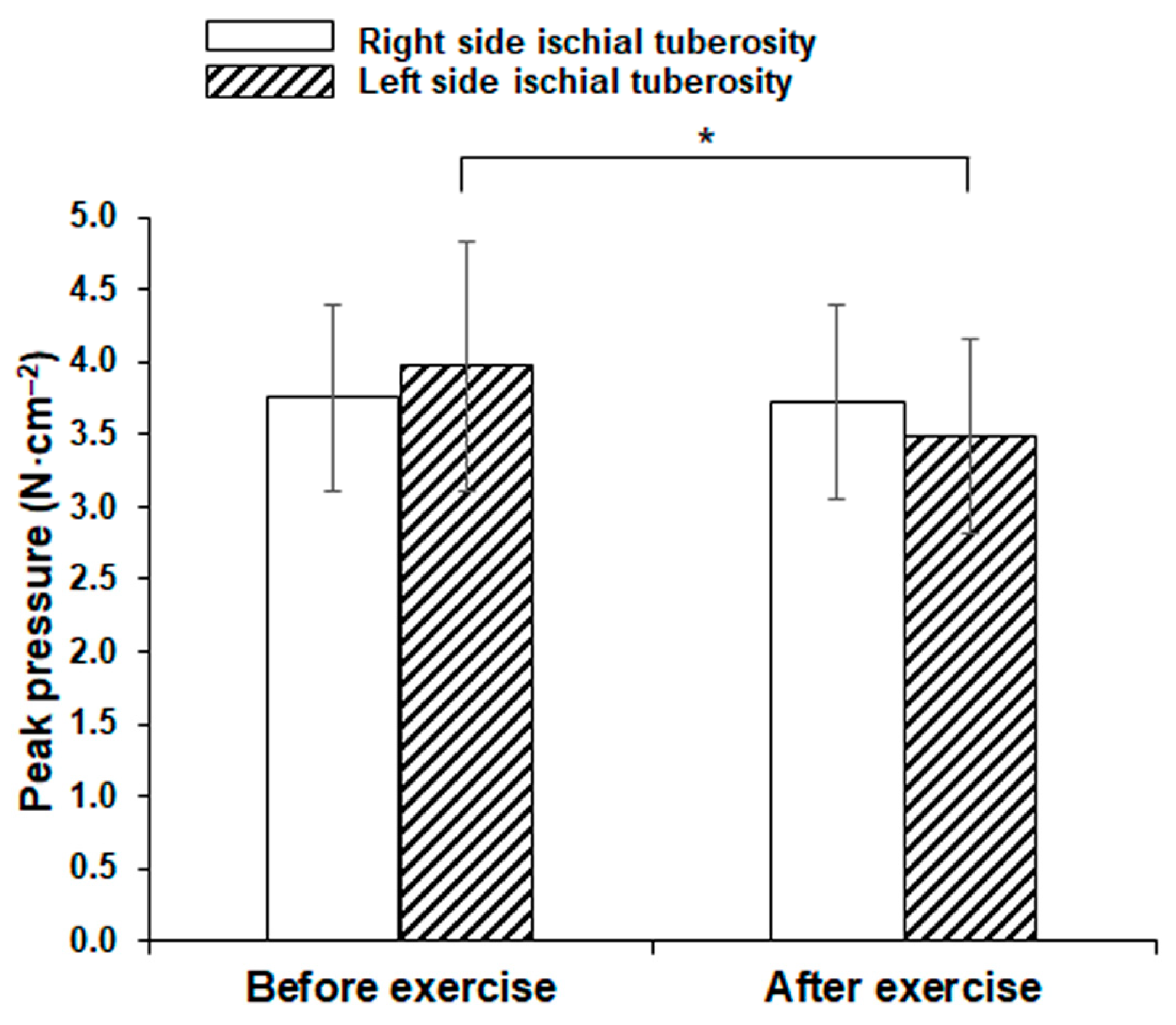
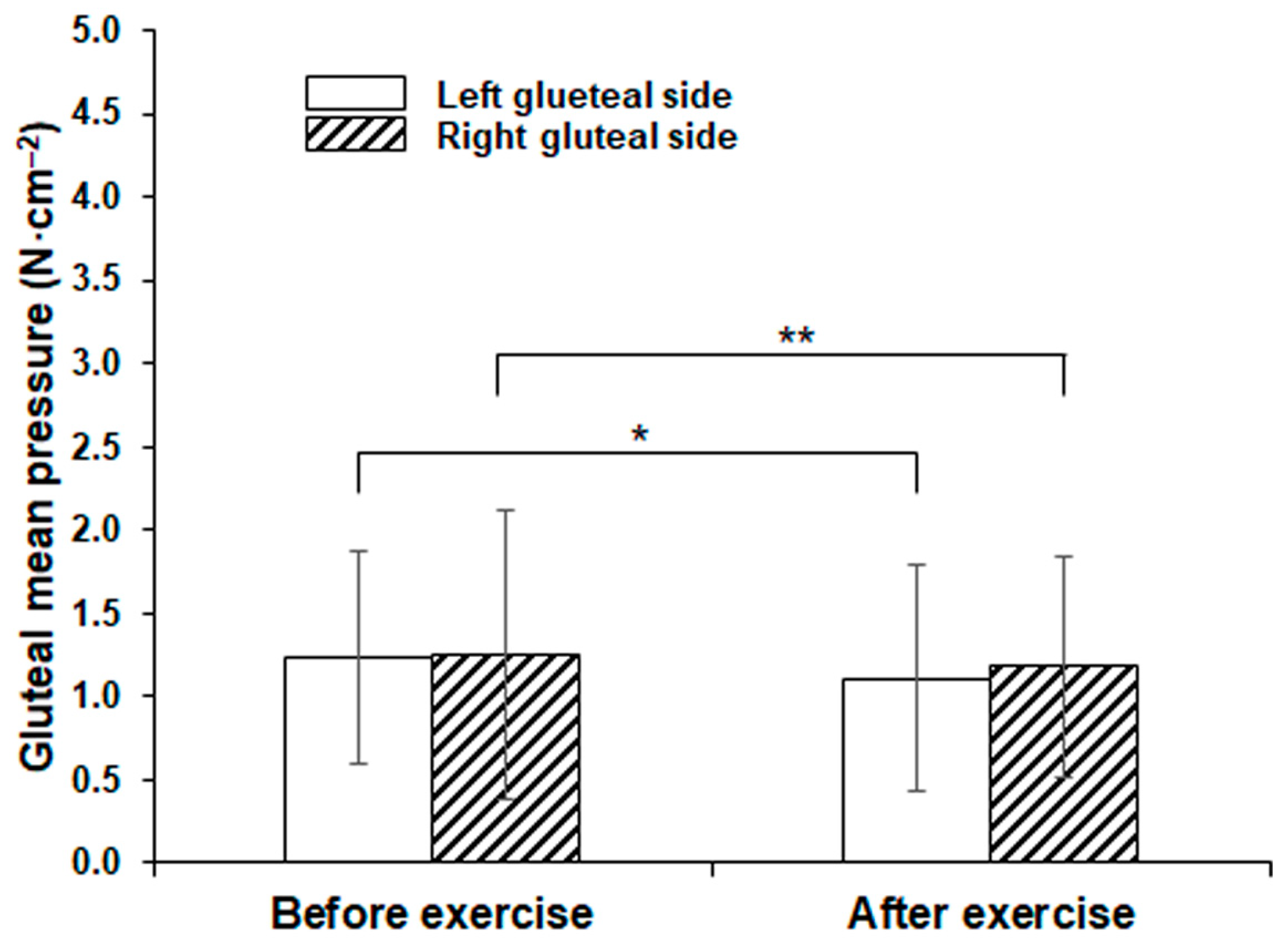
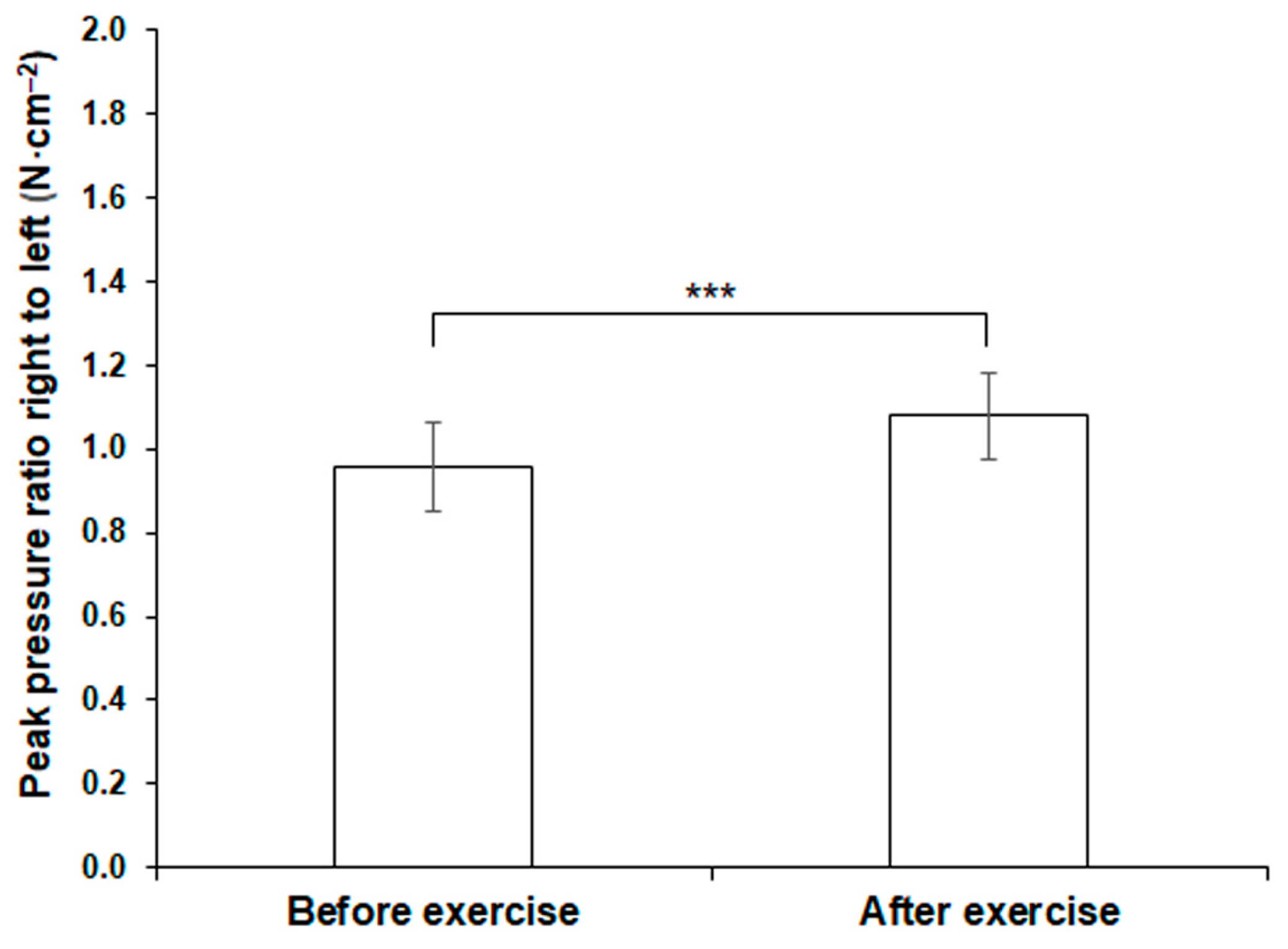
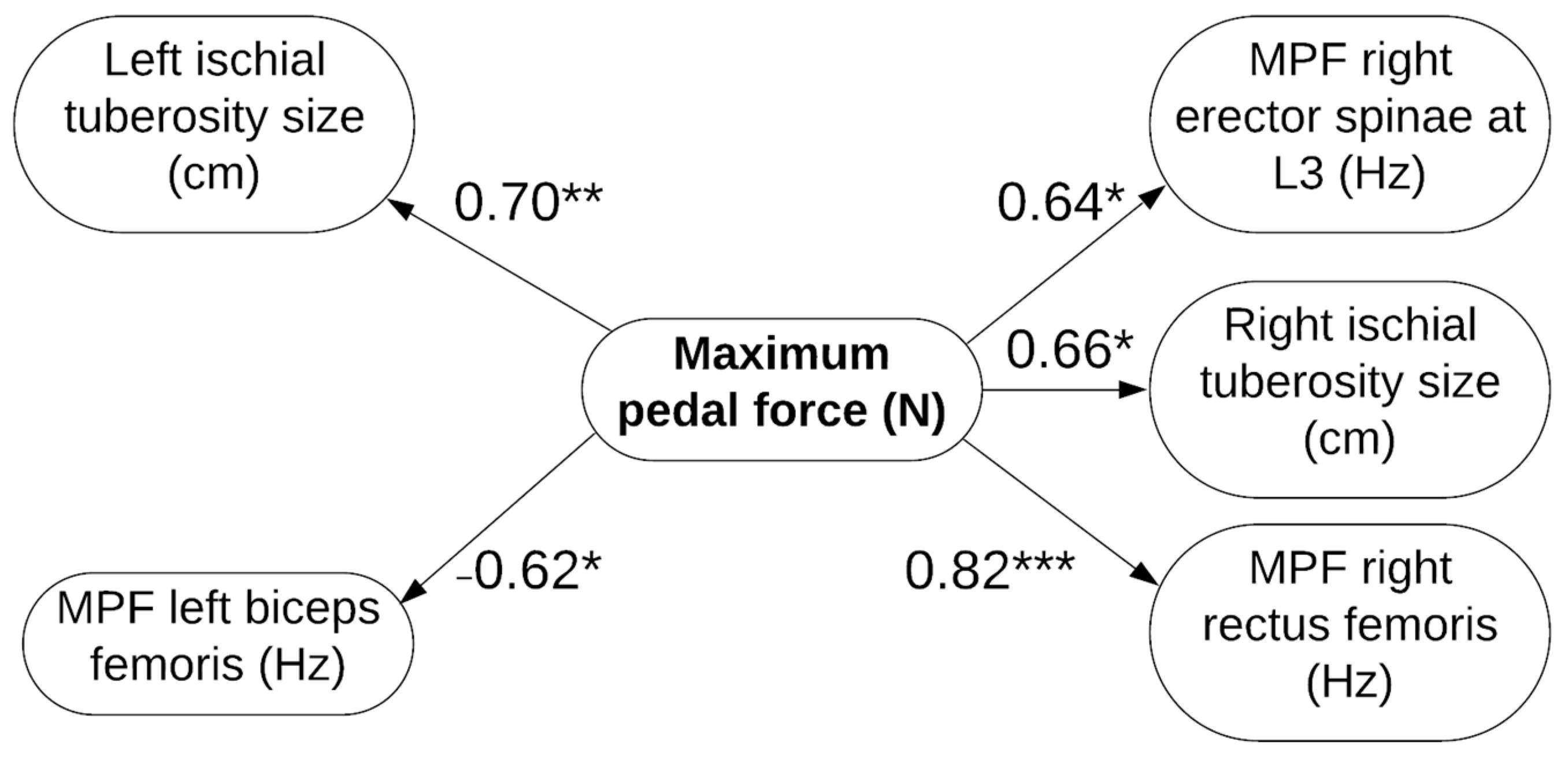
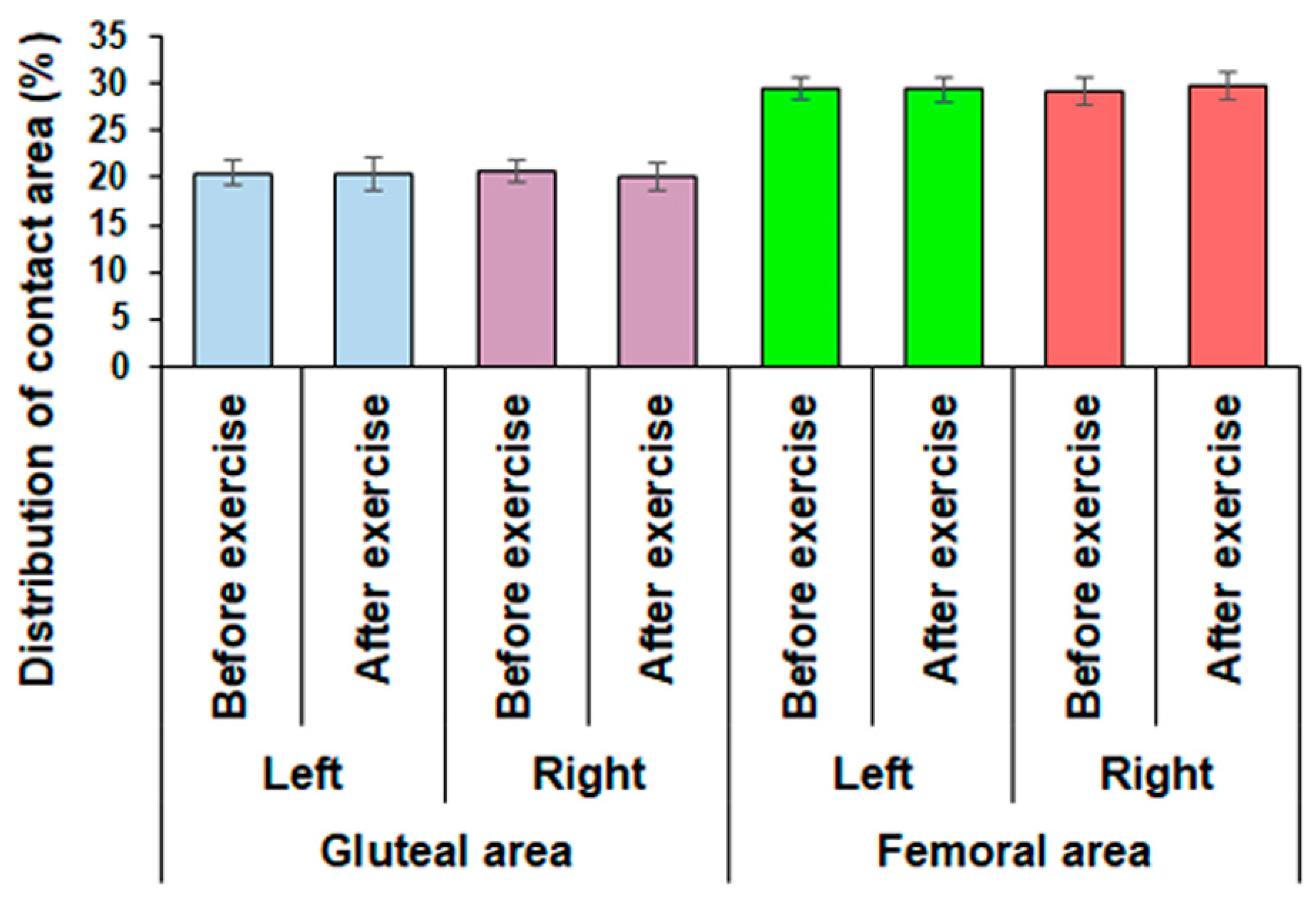
| Main Outcomes | Mean | SD |
|---|---|---|
| Age (years) | 23.2 | 3.5 |
| Body mass (kg) | 74.5 | 6.2 |
| Height (cm) | 185.1 | 5.5 |
| Body mass index (kg/m2) | 21.8 | 1.8 |
| Training history (years) | 9.9 | 2.5 |
| Main Outcomes | Mean | SD |
|---|---|---|
| Body fat (%) | 13.6 | 1.8 |
| Pelvis height (cm) | 24.3 | 1.5 |
| Pelvis width (cm) | 26.4 | 2.7 |
| Right ischial tuberosity size (cm) | 4.1 | 0.3 |
| Left ischial tuberosity size (cm) | 4.2 | 0.4 |
| Main Outcomes | Mean | SD |
|---|---|---|
| 50% Wpeak (W) 1 | 208 | 22.7 |
| Cadence per min | 85.3 | 5.0 |
| Heart rate per min | 140.1 | 6.8 |
| Pedal force (N) | 133.4 | 15.4 |
| Maximal pedal force (N) | 361.5 | 174.7 |
| MPF (Hz) | |||||
|---|---|---|---|---|---|
| Variable | First min | Last min | % Change | p-Value | Effect Size (Cohen’s d) |
| Right erector spinae L3 | 58.5 ± 14.0 | 50.1 ± 15.1 | −14.3 | 0.01 * | 0.55 |
| Left erector spinae L3 | 55.4 ± 16.3 | 56.8 ± 20.8 | 2.6 | 0.84 | 0.07 |
| Right m. gluteus medius | 76.5 ± 14.2 | 77.3 ± 14.8 | 1.1 | 0.72 | 0.05 |
| Left m. gluteus medius | 85.7 ± 24.2 | 82.7 ± 23.2 | −3.5 | 0.03 * | 0.12 |
| Right m. biceps femoris | 61.5 ± 14.9 | 66.1 ± 20.0 | 7.4 | 0.47 | 0.25 |
| Left m. biceps femoris | 74.4 ± 22.8 | 69.0 ± 21.4 | −7.2 | 0.43 | 0.23 |
| Right m. vastus lateralis | 98.3 ± 14.6 | 98.8 ± 17.6 | 0.6 | 0.84 | 0.03 |
| Left m. vastus lateralis | 96.8 ± 20.4 | 96.2 ± 26.7 | −0.7 | 0.87 | 0.02 |
| Right m. rectus femoris | 79.3 ± 9.9 | 81.2 ± 10.3 | 2.4 | 0.35 | 0.18 |
| Left m. rectus femoris | 84.4 ± 17.6 | 79.1 ± 19.2 | −6.3 | 0.37 | 0.27 |
Disclaimer/Publisher’s Note: The statements, opinions and data contained in all publications are solely those of the individual author(s) and contributor(s) and not of MDPI and/or the editor(s). MDPI and/or the editor(s) disclaim responsibility for any injury to people or property resulting from any ideas, methods, instructions or products referred to in the content. |
© 2024 by the authors. Licensee MDPI, Basel, Switzerland. This article is an open access article distributed under the terms and conditions of the Creative Commons Attribution (CC BY) license (https://creativecommons.org/licenses/by/4.0/).
Share and Cite
Lepasalu, L.; Ereline, J.; Reinvee, M.; Pääsuke, M. Seat Pressure Asymmetries after Cycling at Constant Intensity. Symmetry 2024, 16, 270. https://doi.org/10.3390/sym16030270
Lepasalu L, Ereline J, Reinvee M, Pääsuke M. Seat Pressure Asymmetries after Cycling at Constant Intensity. Symmetry. 2024; 16(3):270. https://doi.org/10.3390/sym16030270
Chicago/Turabian StyleLepasalu, Laura, Jaan Ereline, Märt Reinvee, and Mati Pääsuke. 2024. "Seat Pressure Asymmetries after Cycling at Constant Intensity" Symmetry 16, no. 3: 270. https://doi.org/10.3390/sym16030270







